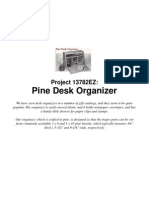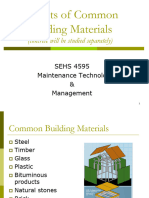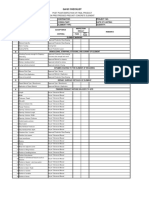Building A Traditional Coffin Smoother
Building A Traditional Coffin Smoother
Uploaded by
Anonymous idUWcnaeCopyright:
Available Formats
Building A Traditional Coffin Smoother
Building A Traditional Coffin Smoother
Uploaded by
Anonymous idUWcnaeOriginal Title
Copyright
Available Formats
Share this document
Did you find this document useful?
Is this content inappropriate?
Copyright:
Available Formats
Building A Traditional Coffin Smoother
Building A Traditional Coffin Smoother
Uploaded by
Anonymous idUWcnaeCopyright:
Available Formats
Published on Norse Woodsmith (http://norsewoodsmith.
com)
By Leif Created 04/15/2004 - 8:43pm
Building a Traditional Coffin Smoother
Building a Coffin Smoother using traditional methods... I go through the steps I took in building this:
Follow the links below: Average: Rate
Your rating: None Average: 4 (1 vote)
Building a Traditional Coffin Smoother
I've been meaning to build myself a traditional smoother, and while I was going to wait until other projects were completed, but
2004-2010 Norse Woodsmith Page 1 of 29
Published on Norse Woodsmith (http://norsewoodsmith.com) decided I would forego some other projects and give it a whirl now. The photo below is what I'm building on the next several pages - be warned, I tend to write in a "stream of consciousness" style, so forgive any rambling that might occur.
The plane built on these pages reflect closely a classic coffin smoother documented in an instructional pamphlet titled "How to Make Wooden Planes", authored by David G. Perch and Leonard G. Lee (of Lee Valley and Veritas Fame). Unfortunately this pamphlet is no longer available (inserted edit - Garrett Wade might have a few copies left). Another good text on building wooden planes where a similar plane is constructed is John Whelan's excellent book "Making Traditional Wooden Planes", available from the Astragal Press. David Perch has authored another book along with Robert Lee which might interest the reader, titled "Wooden Planes and How to Make Them", available through Lee Valley. I've not read it myself, but it' my understanding it is a well written book. Note: Notes formatted in this fashion were made later. in hindsight when I had a chance to reflect back on what had gone right or wrong. I thought it would serve both myself and anyone else reading this better to learn from my mistakes and comment on them, than just to pass over them. This seems like the easiest way to accomplish that. I am assuming, with this documentation, that you the reader is familiar with the shape of the opening to be cut into the plane if you are interested in making one yourself. If not, the shape is common to most wooden planes, and should be studied first hand before attempting your own. But if there is one thing I have learned about woodworking, it's to jump in with both feet, and not be afraid of making a mistake. The worst that can happen is you end up with some heavily worked firewood, but even that would have to include the learning and experience acquired during it's execution. Also remember, I am no "expert" (easily seen in the forthcoming work)- these are just my experiences in building this plane.
Collecting the Material and Preparing the Blank
The first thing I dug up in preparation for this little project was a double iron from a Stanley Handyman #4 size plane. I've never been too happy with that old plane, but always figured I could use the iron for a project like this.
2004-2010 Norse Woodsmith Page 2 of 29
Published on Norse Woodsmith (http://norsewoodsmith.com)
Note: The iron mentioned here did not end up being the iron I used for this plane. This is because they proved to be quite worthless in the end, and it ended up being a mistake to use it here because of its low quality, and have now proved to myself why I was never happy with that particular plane. But more on that later. Next was to find some wood for the wedge. I found a blank of walnut about 2" x 6" that was perfect - contrasted with the maple and was a bit softer - just the right thing for it. Next was to find a suitable block of wood for the body. I had nothing on hand of substantial thickness, and as it was my purpose to spend absolutely nothing to build this smoother, I dug up some scraps of hard maple I had on hand, and glued them together to make a block of the proper depth. I then squared the block to 2-1/2" square and 8" in length. I tried to orient the grain while gluing up the blanks and consequently while marking out the plane so the outer portion of the tree was to the bottom, and so the grain dived towards the back of the plane.
I mark the plane T for top, S for side, making sure to check for optimum grain direction. I then scribe a line 3" back from the front of the block, followed by a line at 50 degrees to mark out the bed of the iron. I then place the assembled iron against this line to determine the base line of the wedge that will be fit later: Note: It is very important that you make the marks telling you the side from the top and front from back. This was actually the latest round of mark making on the blank because I caught myself doing it backwards... Twice. First I had the side on top then the back at the front. WHAT A PUTZ!
Page 3 of 29
Published on Norse Woodsmith (http://norsewoodsmith.com)
2004-2010 Norse Woodsmith
Published on Norse Woodsmith (http://norsewoodsmith.com)
Rate
2004-2010 Norse Woodsmith
Published on Norse Woodsmith (http://norsewoodsmith.com)
These lines are carried across the top of the plane, where they define the opening to be cut in the body of the plane, shown marked out by pencil. The outside parallel lines are the width of the iron plus 1/16", and define the outside edge of the wedge pocket. The inside lines are 1/4" inside of each outside line and define the inside edge of the wedge pocket. The wedge will register against these when installed.
Page 6 of 29
Published on Norse Woodsmith (http://norsewoodsmith.com)
2004-2010 Norse Woodsmith
Published on Norse Woodsmith (http://norsewoodsmith.com)
2004-2010 Norse Woodsmith
Notice how there are several angles that need to be worked within the opening, which can be hard to keep straight in your head I'll refer to this diagram again.
Mortising
Published on Norse Woodsmith (http://norsewoodsmith.com) I then turn the blank over again and remove a large portion of the material through some rapid chopping with a bench chisel, again being careful to stay well within the lines drawn out previously:
Don't worry, I'll clean it up in just a bit. The object here is just to remove as much material as quickly as possible - I'm simply getting the biggest portion of the material out of my way. Average: No votes yet Rate
Mortising
Finishing up the mortising
Having removed as much material as I dare, as quickly as I can, it's time now to clean up the mortise and start to define it with some light tapping and paring:
Page 9 of 29
Published on Norse Woodsmith (http://norsewoodsmith.com)
2004-2010 Norse Woodsmith
Published on Norse Woodsmith (http://norsewoodsmith.com)
2004-2010 Norse Woodsmith
Published on Norse Woodsmith (http://norsewoodsmith.com)
2004-2010 Norse Woodsmith
Published on Norse Woodsmith (http://norsewoodsmith.com)
Rate
2004-2010 Norse Woodsmith
Published on Norse Woodsmith (http://norsewoodsmith.com)
2004-2010 Norse Woodsmith
Published on Norse Woodsmith (http://norsewoodsmith.com)
2004-2010 Norse Woodsmith
Published on Norse Woodsmith (http://norsewoodsmith.com)
2004-2010 Norse Woodsmith
Notice the portion in front of the wedge pocket where it widens the "ear" to the same width as the mouth - can't forget to do that little bit, and now's the time! I accomplished it here with a bed float.
Slotting for the Chipbreaker's Nut
Published on Norse Woodsmith (http://norsewoodsmith.com)
Rate
2004-2010 Norse Woodsmith
Published on Norse Woodsmith (http://norsewoodsmith.com)
2004-2010 Norse Woodsmith
Published on Norse Woodsmith (http://norsewoodsmith.com)
2004-2010 Norse Woodsmith
Published on Norse Woodsmith (http://norsewoodsmith.com)
2004-2010 Norse Woodsmith
Published on Norse Woodsmith (http://norsewoodsmith.com)
2004-2010 Norse Woodsmith
Published on Norse Woodsmith (http://norsewoodsmith.com)
Rate
2004-2010 Norse Woodsmith
Published on Norse Woodsmith (http://norsewoodsmith.com)
2004-2010 Norse Woodsmith
Published on Norse Woodsmith (http://norsewoodsmith.com)
2004-2010 Norse Woodsmith
Then, using a 6" steel ruler, I bent an approximate shape as shown above and marked it with a pencil. Over at the bandsaw, I cut it out, staying proud of the line by about an 1/8". I didn't want to thin out the walls of the mortise too much, so I simply avoided them. Then, to smooth it out, I took a belt sander on it's side after it:
Published on Norse Woodsmith (http://norsewoodsmith.com)
I actually built a jig for this belt sander (another Craftsman - what wonderful tools - I'm just so happy with them can't you tell?) so that I can use it more like a stationary tool - but alas, the price one pays for having a small shop means jigs such as that are stuck way up behind and under fourteen other things... oh, I'm wandering off subject again. Fortunately, this one has a pretty flat side to rest on the bench that's close enough to perpendicular to actually work.
Cosmetics
Once I get the shape I want, I round all of the outside corners of the plane that are rounded off, and make a few other cosmetic touches. Note: Here is a good place to stop and tune the plane, before the cosmetic touches are added. I know I said it before, above - I just want to make sure I drive this point home.
Everything below the notch made in the side is left square. Next, I'll talk about tuning the thing, what I should have done before the mad rush to the end... Have I made clear the point about how I shouldn't have rushed through this part, yet? Do I seem repetitious about it? Am I annoying anyone with it yet? Average: No votes yet
2004-2010 Norse Woodsmith Page 25 of 29
Published on Norse Woodsmith (http://norsewoodsmith.com) Rate
Tuning the Plane
Tuning the plane
Now, I had the plane complete - but it wouldn't work worth squat. The iron wouldn't stay in place like it should, and as a result I couldn't get it to work decently at all. My rushing at the last minute, combined with the euphoria created from winning the battle of Ragnarok with the riding lawn mower had done it's damage. It was time to do some diagnostics and some tuning. First thing I noticed was the iron was sharpened just a bit off of perpendicular. Not enough for me to notice by eye, but put a square to it, and it was obvious. I had sharpened this iron by hand a long time ago, and the plane it came out of had enough adjustment to make up for its off-kiltered sharpening, but not this one. I had noticed I needed to keep knocking the side to get it to line up, and it would go, but I think this was loosening the grip just enough on one side of the wedge to be an issue. Then, I re-trued the shoulder the wedge fits against - turned out that one side was just a tad higher than the other - not much, but enough so the pressure the wedge would exert on the iron was just a little less on one side that the other - this is more of a problem when combined with the previous one. Then, I added a bit more "spring" to the chipbreaker. Now I could get the plane to hold its set better, but it was still a bit difficult to get it to plane evenly. I also noticed I had made the wedge too long. It was going over the hump of the chip breaker too far and serving as a catch point for shavings - they would build up in a corner of the mouth and force the iron up after a while. Next, I stuck the iron in the plane with its nice new sharpening, held the plane up to the light and pulled the iron back, looking to see light coming from between the iron and the bed. I noticed I had just the *slightest* crown in the center of the bed for the iron, about 1/4" - 1/2" up from the mouth. It would have been better had it been the opposite, with a slight dip in the center rather than a hump - as now it actually has to bend the iron slightly across it's width (just barely - but enough when in combination with the other factors that it wouldn't hold it's set). It would have been handy to have a bed float that was about 3/4" to 1" wide for its full length - it was the pointed bed float that got me into trouble here. That one is really better for doing the sides of the iron pocket rather than the bed itself. When I made those, I was thinking of a side escapement or molding plane, not a smoother, and then decided to do a smoother first. Typical process for me, there. But - the bed for the iron needs to be dead flat:
Page 26 of 29
Published on Norse Woodsmith (http://norsewoodsmith.com)
2004-2010 Norse Woodsmith
Published on Norse Woodsmith (http://norsewoodsmith.com)
2004-2010 Norse Woodsmith
Published on Norse Woodsmith (http://norsewoodsmith.com) iron. The plane built in this article was done as a prototype - to see what was involved, so in that regards, it was successful but as a user... it could be better, as the curved portion of the chipbreaker does not lend itself to easy adjustment in this style of plane. 7/27/04 I've finished another smoothing plane that, if you've read this all the way to the end, might interest you... You can find documentation on it here.
I hope you've found this interesting, and of some worth. Thanks for reading! Average: Your rating: None Average: 5 (3 votes) Rate Toolmaking
Source URL: http://norsewoodsmith.com/content/building-traditional-coffin-smoother
2004-2010 Norse Woodsmith Page 29 of 29
You might also like
- ShopNotes Vol.18 Issue 107Document52 pagesShopNotes Vol.18 Issue 107rftoto100% (3)
- Wooden Toy Spacecraft: Explore the Galaxy & Beyond with 13 Easy-to-Make Woodworking ProjectsFrom EverandWooden Toy Spacecraft: Explore the Galaxy & Beyond with 13 Easy-to-Make Woodworking ProjectsRating: 5 out of 5 stars5/5 (1)
- Pine Desk Organizer: Project 13782EZDocument6 pagesPine Desk Organizer: Project 13782EZBSulli100% (1)
- 1990 1 JanFebDocument25 pages1990 1 JanFebRocio Mtz100% (1)
- Foam System ManualDocument66 pagesFoam System Manualriyasudeen786No ratings yet
- Creating Wooden Boxes on the Scroll Saw: Patterns and Instructions for Jewelry, Music, and Other Keepsake BoxesFrom EverandCreating Wooden Boxes on the Scroll Saw: Patterns and Instructions for Jewelry, Music, and Other Keepsake BoxesRating: 5 out of 5 stars5/5 (1)
- The Pilgrims Visit Rome: A 17th-Century Style Carved Box Made Using Hand Tools & Mini-Roman WorkbenchFrom EverandThe Pilgrims Visit Rome: A 17th-Century Style Carved Box Made Using Hand Tools & Mini-Roman WorkbenchNo ratings yet
- Sash PlanesDocument5 pagesSash PlanesBlakdawg15100% (1)
- English Layout SquareDocument2 pagesEnglish Layout Squarev00d00bluesNo ratings yet
- Sanding BlockDocument3 pagesSanding BlockOlavo Pastore100% (1)
- Wooden Scrub Plane From ScrapDocument9 pagesWooden Scrub Plane From ScrapRod HyattNo ratings yet
- 15" Wooden Jack Fore Plane Plans by Caleb JamesDocument2 pages15" Wooden Jack Fore Plane Plans by Caleb Jamesmanic888No ratings yet
- Woodworkers Journal - June 2014 USADocument68 pagesWoodworkers Journal - June 2014 USAZeferin-o100% (3)
- Leg Tapering Jig: Project 14585EZDocument5 pagesLeg Tapering Jig: Project 14585EZBSulliNo ratings yet
- Spindle Turning: Fine Points For The BeginnerDocument6 pagesSpindle Turning: Fine Points For The Beginnerapi-25885411No ratings yet
- Stanley Number 5 and Up Plane Tote C 06 eDocument3 pagesStanley Number 5 and Up Plane Tote C 06 eArturo Isaak Gonzalez Palazuelos50% (2)
- Garys Making A Coffin Smoothing PlaneDocument24 pagesGarys Making A Coffin Smoothing PlaneBenjamin LunaNo ratings yet
- Hank Ou: Get More From Your Table SawDocument6 pagesHank Ou: Get More From Your Table Sawasg0401No ratings yet
- Block PlaneDocument1 pageBlock PlaneSanela Ljubičić100% (4)
- Chisel CaseDocument4 pagesChisel CasePeter WestNo ratings yet
- Shop CartDocument3 pagesShop Cartgmand68No ratings yet
- A Classic Case: A Project Plan For A Case With A Modern Take On An Arts and Crafts ClassicDocument7 pagesA Classic Case: A Project Plan For A Case With A Modern Take On An Arts and Crafts ClassicMushroom Love Stars CrUz100% (1)
- Dovetail Key JoineryDocument3 pagesDovetail Key Joineryricheklund100% (4)
- Hank Ou: Get More From Your Table SawDocument12 pagesHank Ou: Get More From Your Table Sawrefsocrd1No ratings yet
- Hollows and RoundsDocument3 pagesHollows and RoundsMitch ArchNo ratings yet
- Router Fence Plans PDFDocument1 pageRouter Fence Plans PDFAntonio CanabarroNo ratings yet
- Easy Resawing: The Fence. The FenceDocument2 pagesEasy Resawing: The Fence. The FenceBilAndersenNo ratings yet
- Small Colonial Bench: Project 10297EZDocument5 pagesSmall Colonial Bench: Project 10297EZmhein68No ratings yet
- SN11424 - Shop Made Hand PlanesDocument15 pagesSN11424 - Shop Made Hand PlanesCarlos100% (2)
- Disc Sander Circle JigDocument1 pageDisc Sander Circle JigFrancois VaaltynNo ratings yet
- 278562d1494648120 Scandinavian Workbench Restoration Moravian Workbench Cut List PDFDocument1 page278562d1494648120 Scandinavian Workbench Restoration Moravian Workbench Cut List PDFMike CongdonNo ratings yet
- 03 PDFDocument68 pages03 PDFGeorge Vlad AndronicNo ratings yet
- Woodsmith - 032Document24 pagesWoodsmith - 032rsotoqp100% (2)
- 1 Block PlaneDocument2 pages1 Block PlaneOsvaldo MoraesNo ratings yet
- Wall Hung Magazine and Book Rack: Project 14211EZDocument3 pagesWall Hung Magazine and Book Rack: Project 14211EZBSulliNo ratings yet
- Dovetailed Tool BoxDocument13 pagesDovetailed Tool Boxdavid100% (1)
- Shopnotes 88 Dovetailed Shoulder PlaneDocument8 pagesShopnotes 88 Dovetailed Shoulder PlaneJulio Cesar OliveiraNo ratings yet
- Coffe TableDocument15 pagesCoffe TableJun Vargas100% (1)
- Woodsmith Index 1-174Document24 pagesWoodsmith Index 1-174jlpicardNo ratings yet
- Woodcraft Magazine - October-November 2020Document70 pagesWoodcraft Magazine - October-November 2020Adrian SeketaNo ratings yet
- 2 - Woodworking Plans - OakplateDocument6 pages2 - Woodworking Plans - OakplatemacpatorNo ratings yet
- Classic Flag Case: © 2014 August Home Publishing CoDocument11 pagesClassic Flag Case: © 2014 August Home Publishing Cokostas1977No ratings yet
- Chamfer PlaneDocument3 pagesChamfer PlaneFred171717100% (1)
- Popular Woodworking - 018 - 1984 PDFDocument48 pagesPopular Woodworking - 018 - 1984 PDFKawchhar Ahammed100% (1)
- ShopNotes Issue 38 PDFDocument32 pagesShopNotes Issue 38 PDFbenignoNo ratings yet
- Shopnotes 88 Dovetailed Shoulder Plane PDFDocument8 pagesShopnotes 88 Dovetailed Shoulder Plane PDFlacc2211No ratings yet
- American Woodworker 163 2012-2013 PDFDocument76 pagesAmerican Woodworker 163 2012-2013 PDFkaskdos100% (1)
- Herramientas para Trazar y MedirDocument51 pagesHerramientas para Trazar y MedirFranco Mauricio50% (6)
- How To Make A Japanese PlaneDocument4 pagesHow To Make A Japanese PlaneRod HyattNo ratings yet
- WoodPlans Online - It's A KeeperDocument12 pagesWoodPlans Online - It's A KeeperЧедомир Арнаут100% (2)
- Chisel CabinetDocument3 pagesChisel CabinetErika Ramirez100% (4)
- Adirondack Rocking Chair PlansDocument19 pagesAdirondack Rocking Chair PlansMoises Barbosa100% (1)
- Sept2007 WM2 PDFDocument49 pagesSept2007 WM2 PDFBaSzar100% (2)
- Bandsaw Circle JigDocument3 pagesBandsaw Circle Jigphilipisaia100% (1)
- Stacking Desk Tray: Project 19874EZDocument4 pagesStacking Desk Tray: Project 19874EZBSulliNo ratings yet
- Cópia de CR Fine Woodworking PlanemakingDocument8 pagesCópia de CR Fine Woodworking PlanemakingjrjuliaoNo ratings yet
- Portable Sandpaper StorageDocument3 pagesPortable Sandpaper Storagegmand68100% (1)
- 3 Tool Chest TopDocument5 pages3 Tool Chest TopAguinaldo OliveiraNo ratings yet
- A Little Book of Vintage Designs and Instructions for Making Dainty Gifts from Wood. Including a Fitted Workbox, a Small Fretwork Hand Mirror and a Lady's Brush and Comb Box: Including a Fitted Workbox, a Small Fretwork Hand Mirror and a Lady's Brush and Comb Box.From EverandA Little Book of Vintage Designs and Instructions for Making Dainty Gifts from Wood. Including a Fitted Workbox, a Small Fretwork Hand Mirror and a Lady's Brush and Comb Box: Including a Fitted Workbox, a Small Fretwork Hand Mirror and a Lady's Brush and Comb Box.No ratings yet
- Test Report On Extraction of Bitumen From Bituminous Paving Mixture and Mechanical Size AnalysisDocument12 pagesTest Report On Extraction of Bitumen From Bituminous Paving Mixture and Mechanical Size AnalysisLakmal JayashanthaNo ratings yet
- Supply Chain Management of Honda & ToyotaDocument52 pagesSupply Chain Management of Honda & Toyotaankit2k91% (44)
- TM-9-6115-645-10 Genset ManualDocument168 pagesTM-9-6115-645-10 Genset ManualMarvin VegaNo ratings yet
- SEFAR® StreamTex Liquid Filtration Products AU High ResolutionDocument36 pagesSEFAR® StreamTex Liquid Filtration Products AU High Resolutionphạm trung hậuNo ratings yet
- PT BM 183 DC 00007 PWHT ProcedureDocument7 pagesPT BM 183 DC 00007 PWHT Procedureeldobie3100% (1)
- Weft KnittingDocument5 pagesWeft KnittingKIRTI PATELNo ratings yet
- Main Types of ThinFlex Materials For Flex BoardDocument4 pagesMain Types of ThinFlex Materials For Flex BoardjackNo ratings yet
- Ashirvad Agri Pipes Fittings 2Document2 pagesAshirvad Agri Pipes Fittings 2Khasimvali ShaikNo ratings yet
- Section 11Document13 pagesSection 11Jacky TiongNo ratings yet
- Electrical Fires: Prevention, Detection & ProtectionDocument18 pagesElectrical Fires: Prevention, Detection & ProtectionBhavani Prasad100% (1)
- Chennai New Catalogue-1Document50 pagesChennai New Catalogue-1yopyopNo ratings yet
- 321635.CIGRE WG A306 Rio 2008Document22 pages321635.CIGRE WG A306 Rio 2008Sukant BhattacharyaNo ratings yet
- Eco BrickDocument10 pagesEco BrickROY SETIAWANNo ratings yet
- PTIT Statistic 2014Document24 pagesPTIT Statistic 2014Thitikorn WassanarpheernphongNo ratings yet
- Gyratory Mill: EccentricDocument10 pagesGyratory Mill: EccentricAbhishek Kumar100% (1)
- Compressor WashingDocument7 pagesCompressor Washingsamil68100% (1)
- Alimak O & M STH5Document67 pagesAlimak O & M STH5Luis Alcala100% (2)
- Thread Pipe NippleDocument1 pageThread Pipe NippleJuditaNo ratings yet
- Verona Tech RegulationsDocument18 pagesVerona Tech RegulationsChaitanya BhansaliNo ratings yet
- Standardi Za IbrDocument16 pagesStandardi Za IbrMilica AnticNo ratings yet
- Energy Saving in Compressed Air PointsDocument2 pagesEnergy Saving in Compressed Air PointsSwapnil PatadeNo ratings yet
- CatalogueDocument106 pagesCataloguePelagiumNo ratings yet
- 2 Defects of Common BLDG MaterialsDocument40 pages2 Defects of Common BLDG Materialsjohnnyferry2No ratings yet
- Post Pour Inspection ChecklistDocument2 pagesPost Pour Inspection Checklistwalidtkh78No ratings yet
- Stock Filters All NewDocument8 pagesStock Filters All Newmasthan6yNo ratings yet
- S# Item C Waterproofing On SurfacesDocument8 pagesS# Item C Waterproofing On SurfacesDeepa Junnarkar Degwekar100% (1)
- Revision Paper Physics-12, Unit-IIIDocument2 pagesRevision Paper Physics-12, Unit-IIIprasun pratikNo ratings yet
- @airbus: Airbus S.A.SDocument280 pages@airbus: Airbus S.A.Sjoker hotNo ratings yet
























































































